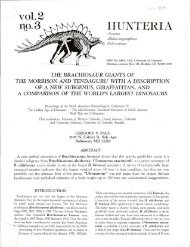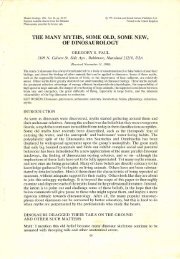Dinosaur models: the good, the bad, and using - Gregory S. Paul
Dinosaur models: the good, the bad, and using - Gregory S. Paul
Dinosaur models: the good, the bad, and using - Gregory S. Paul
You also want an ePaper? Increase the reach of your titles
YUMPU automatically turns print PDFs into web optimized ePapers that Google loves.
facial muscles. In many dinosaur mounts <strong>and</strong> restorations <strong>the</strong><br />
chest ribs are positioned vertically, like those of mammals, but<br />
<strong>Paul</strong> (1987, 1988a,b, 1996) <strong>and</strong> Carpenter et al. (1994) observed<br />
that all dinosaurs' chest ribs are swept back like crocodilians<br />
<strong>and</strong> birds (this can be seen in many articulated skeletons). Because<br />
<strong>the</strong> rib heads articulate with <strong>the</strong> vertebrae at an oblique<br />
angle, swinging <strong>the</strong> ribs backwards also swings <strong>the</strong>m inwards.<br />
The shoulder girdle is accordingly both pulled back <strong>and</strong> narrowed<br />
(to <strong>the</strong> point that <strong>the</strong> coracoids almost meet on <strong>the</strong> midline).<br />
In quadrupedal reptiles <strong>the</strong> shoulder joint is just forward<br />
of or astride <strong>the</strong> first long dorsal rib, so <strong>the</strong> majority of <strong>the</strong><br />
scapula is astride <strong>the</strong> chest ribs. The resulting tight fit between<br />
girdle <strong>and</strong> chest maximizes <strong>the</strong> amount of supporting muscles<br />
that connect <strong>the</strong> two, <strong>the</strong> same should have been true of fully<br />
or semi-quadrupedal dinosaurs. In a few dinosaur specimens<br />
(small ornithopods, AppendFig. 1) <strong>the</strong> sternal ribs are ossified<br />
<strong>and</strong> still connect <strong>the</strong> ribs <strong>and</strong> sternal plates, with <strong>the</strong> latter being<br />
just in front of <strong>the</strong> front ribs. In o<strong>the</strong>r articulated skeletons <strong>the</strong><br />
sternals are set just forward of <strong>the</strong> first long dorsal rib (PIs. 7A,<br />
18, 19 in Lull & Wright, 1942). Because <strong>the</strong> lower end of <strong>the</strong><br />
shoulder blade articulates with <strong>the</strong> sternal plates <strong>the</strong> shoulder<br />
girdle is not far ahead of <strong>the</strong> ribs, <strong>and</strong> <strong>the</strong> shoulder joint is just<br />
forward of or astride <strong>the</strong> first ribs. This tight fit is seen in <strong>the</strong><br />
best articulated dinosaur skeletons (see PIs. 9A, 12B, 13, 17B,<br />
18, 22B, 24B, 27, 31 in Lull & Wright, 1942). The position of<br />
nerves that fed <strong>the</strong> forelimb also support a posterior position for<br />
<strong>the</strong> shoulder girdle (in predatory dinosaurs according to Giffin<br />
[1995], <strong>and</strong> <strong>the</strong> same configuration appears true of quadrupedal<br />
dinosaurs). In some skeletons <strong>the</strong> shoulder girdle is found more<br />
down <strong>and</strong> forwards, but sternal elements are displaced <strong>and</strong> <strong>the</strong><br />
girdle was probably pushed out by bloating of <strong>the</strong> carcass (contrary<br />
to Carpenter et al. [1994] who indicates this was <strong>the</strong> life<br />
position in dinosaurs). These combined factors significantly reduce<br />
chest <strong>and</strong> shoulder volume both front <strong>and</strong> sides compared<br />
to traditional restorations.<br />
In most dinosaurs <strong>the</strong> trunk <strong>and</strong>/or tail vertebrae were heavily<br />
braced in some manner, so it is probable that (as in stiff bodied<br />
birds) <strong>the</strong> back musculature was not as well developed as in<br />
more flexible bodied reptiles <strong>and</strong> mammals. The erect tail carriage<br />
that appears to be common to all dinosaurs implies that<br />
<strong>the</strong>ir tails did not bear massive burdens of flesh, but <strong>the</strong>re is<br />
latitude in restoring this factor. Reptiles have short hips <strong>and</strong> narrow<br />
thigh muscles, <strong>the</strong> same appears to have been true of <strong>the</strong><br />
most primitive dinosaurs. Birds <strong>and</strong> mammals have long upper<br />
hip bones that support broad thigh muscles, this applies to most<br />
dinosaurs (so <strong>the</strong> narrow thighs restored by Knight [see <strong>Paul</strong>,<br />
1996b] are not correct). Fossil dinosaur footprints often help<br />
determine <strong>the</strong> volume of <strong>the</strong> soft tissues of <strong>the</strong> feet <strong>and</strong> lower<br />
limbs of various types. To a certain extent muscling dinosaurs<br />
is a matter of common sense. Nei<strong>the</strong>r <strong>the</strong> massive amounts of<br />
soft tissue draped over <strong>the</strong> skeletal frameworks in many traditional<br />
restorations, nor <strong>the</strong> extremely emaciated condition in<br />
some recent restorations (as per Russell, 1989) are plausible.<br />
Predatory <strong>Dinosaur</strong>s, Those Lean Mean Fighting Machines<br />
Restorations <strong>and</strong> mass estimates of predatory dinosaurs are<br />
detailed in <strong>Paul</strong> (1988b), some new <strong>and</strong> updated examples are<br />
presented in Figure 3. In top view chests were broader than<br />
waists, as in mammalian carnivores. Of all dinosaurs, <strong>the</strong> smallbellied<br />
predators are <strong>the</strong> ones in which <strong>the</strong> appendages have <strong>the</strong><br />
most influence upon total body mass.<br />
Traditionally, <strong>the</strong> largest predatory dinosaur has been Tyrannosaurus.<br />
Mass estimates as high as 12 tonnes (paul, 1988b) are<br />
excessive. New large specimens are ei<strong>the</strong>r too incomplete or<br />
have not been published in sufficient detail to allow accurate<br />
skeletal restorations <strong>and</strong> mass estimates, what has been revealed<br />
Dinofest® International Proceedings<br />
135<br />
FIGURE 4-Supporting tissues of sauropod neck cross sections, to same<br />
approximate scale. Two left figures are Diplodocus, on right is Brachiosaurus.<br />
The top left figure shows <strong>the</strong> large nuchal ligament (stippled)<br />
lying between <strong>the</strong> V-spines restored by Alex<strong>and</strong>er (1989), who<br />
assumed a heavy solid neck. Lower figure shows that ligaments (stippled)<br />
probably connected spines of succeeding vertebrae directly to one<br />
ano<strong>the</strong>r, <strong>and</strong> that <strong>the</strong>y did not need to be so thick because <strong>the</strong> neck was<br />
pneumatic, so a groove may have lain between <strong>the</strong> V-spines. The nuchal<br />
ligament (stippled) that may have helped carry <strong>the</strong> neck of brachiosaurs<br />
is shown, note that it was probably narrow. Also indicated<br />
are <strong>the</strong> excavations that lightened sauropod vertebrae (dotted lines) to<br />
<strong>the</strong> point that <strong>the</strong>ir centers consisted of a thin vertical wall, <strong>and</strong> <strong>the</strong><br />
restored gullet <strong>and</strong> trachea (smaller passage) on <strong>the</strong> underside of each<br />
neck. Note <strong>the</strong> complex cross sectional shapes of sauropod necks, unlike<br />
<strong>the</strong> simple semi-circles shown in most restorations.<br />
suggests that <strong>the</strong> biggest specimens approached 8 tonnes. Recently,<br />
new predatory dinosaurs have challenged <strong>the</strong> status of<br />
Tyrannosaurus as <strong>the</strong> biggest, again we await more details. The<br />
largest unpreserved world record individual predatory dinosaurs<br />
probably approached 15 tonnes.<br />
Herbivorous <strong>Dinosaur</strong>s<br />
Restorations <strong>and</strong> mass estimates of herbivorous dinosaurs are<br />
presented in <strong>the</strong> Appendix. In top view <strong>the</strong> chest was narrower<br />
than <strong>the</strong> belly, as in herbivorous mammals, <strong>and</strong> restorations that<br />
show <strong>the</strong> plant eating dinosaurs with hollow bellies are in serious<br />
error.<br />
Therizinosaurs, Heavily Weird<br />
Therizinosaurs are <strong>the</strong> dinosaurs designed by <strong>the</strong> committee<br />
on psychedelics. No complete skeleton is known, so mass estimates<br />
are imprecise. The front portion of <strong>the</strong> pelvis was extremely<br />
broad, indicating that <strong>the</strong> belly was equally so. Therizinosaurus<br />
had arms 2.5 m long, <strong>and</strong> weighed about 3 tonnes.<br />
Sauropods, <strong>the</strong> L<strong>and</strong> Whales<br />
It is not surprising that <strong>the</strong> largest l<strong>and</strong> animals of all time<br />
have been <strong>the</strong> focus of many attempts to estimate <strong>the</strong>ir bulk. Did<br />
any approach or equal <strong>the</strong> size of <strong>the</strong> largest whales?<br />
The now stony neck bones are often restored with a massive<br />
musculature, but <strong>the</strong> actually lightweight pneumatic vertebrae<br />
were probably supported by a musculature so minimal that <strong>the</strong>









